|
|
|
Pasteli
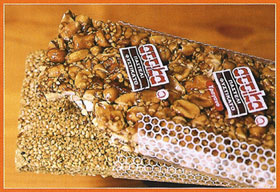 In
every peripteron in Greece, you will find a
candy bar which is reminiscent of the
natural food movement prevalent in the
1980s. Pasteli, however, is one of the
conerstones of Greek confectionery.
The classic pasteli consists simply of
sesame seeds baked with honey, and is
therefore indigenous to the sesame-growing
area around Thessaloniki, but almond,
filbert and peanut pasteli have also become
increasingly popular and are manufactured
nationwide. This is not surprising in
a country that produces such an abundance of
nuts. Almonds grow in rocky regions,
filberts and walnuts in agricultural areas
and peanuts come from Cyprus. In
every peripteron in Greece, you will find a
candy bar which is reminiscent of the
natural food movement prevalent in the
1980s. Pasteli, however, is one of the
conerstones of Greek confectionery.
The classic pasteli consists simply of
sesame seeds baked with honey, and is
therefore indigenous to the sesame-growing
area around Thessaloniki, but almond,
filbert and peanut pasteli have also become
increasingly popular and are manufactured
nationwide. This is not surprising in
a country that produces such an abundance of
nuts. Almonds grow in rocky regions,
filberts and walnuts in agricultural areas
and peanuts come from Cyprus.
There are still a good many pasteli bakeries
in this, the home region of pasteli.
The aroma emanating from the bakeries can
easily make you believe that pasteli may
well have something to do with the legendary
nectar and ambrosia that found their way
here from nearby Olympus.
| |
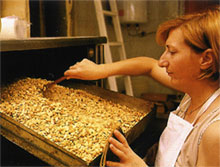 |
|
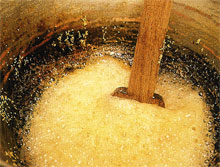 |
|
| |
The sesame seeds or peanuts
need to be evenly roasted
for pasteli |
|
Boil the honey and sugar
until it forms a compact
mass. The firmer the
mass, the quicker the
pasteli will set. |
|
| |
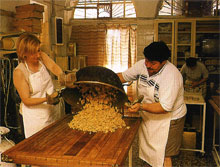 |
|
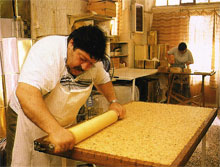 |
|
| |
Tip the mixture of sugar and
sesame seeds (or peanuts)
out onto a flat surface |
|
Use a rolling pin to spread
the mixture into a thin
layer, a process which
requires a great deal of
skill |
|
|
|
excerpts from:
"Culinaria Greece"
|
Copyright ©2001 - 2008
GreekCuisine.com. All rights reserved.
GreekCuisine.com is part of the
GoGreece.com network
2665 30th Street Suite 214, Santa Monica, CA 90405 USA
|